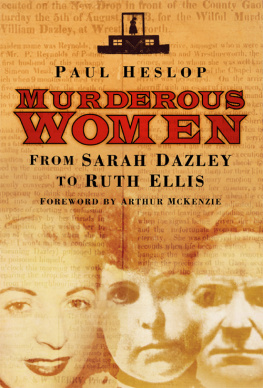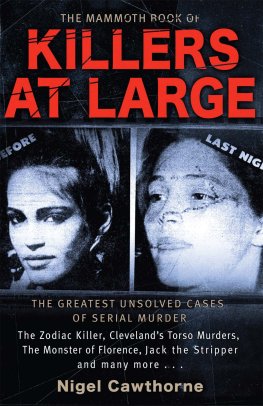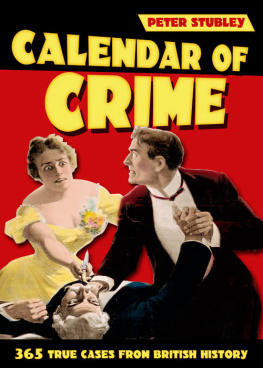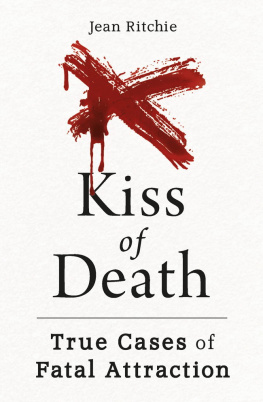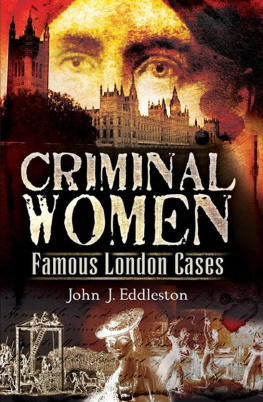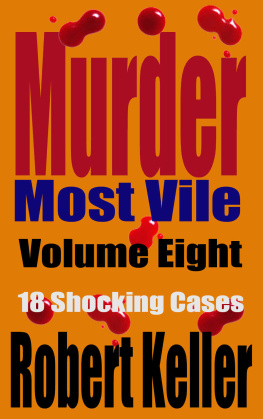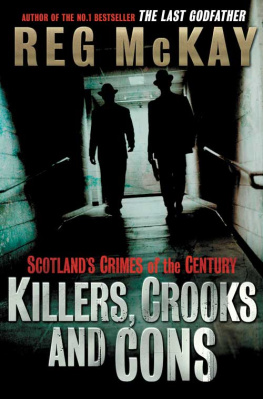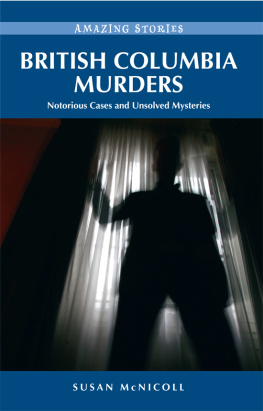P AUL H ESLOP
F ROM S ARAH D AZLEY
TO R UTH E LLIS
Truth will come to light; murder cannot be hid long.
William Shakespeare, The Merchant of Venice
First published 2009
The History Press
The Mill, Brimscombe Port
Stroud, Gloucestershire, GL 5 2 QG
www.thehistorypress.co.uk
This ebook edition first published in 2011
All rights reserved
Paul Heslop, 2009, 2011
The right of Paul Heslop, to be identified as the Author of this work has been asserted in accordance with the Copyrights, Designs and Patents Act 1988.
This ebook is copyright material and must not be copied, reproduced, transferred, distributed, leased, licensed or publicly performed or used in any way except as specifically permitted in writing by the publishers, as allowed under the terms and conditions under which it was purchased or as strictly permitted by applicable copyright law. Any unauthorised distribution or use of this text may be a direct infringement of the authors and publishers rights, and those responsible may be liable in law accordingly.
EPUB ISBN 978 0 7524 7430 4
MOBI ISBN 978 0 7524 7429 8
Original typesetting by The History Press
Contents
Foreword
A s a former colleague and personal friend of Paul Heslop for forty years, there is no one better qualified to focus on the subject of murderous women.
A few years ago I accompanied Paul to the former home of multiple killer Mary Anne Cotton in West Auckland, when he was researching the case for a television documentary. He identified the house from old photographs, and knocked at the door. The current occupant had scant knowledge of the houses history (maybe just as well). However, immediately on entry Paul began to immerse himself into the atmosphere of this simple, small terraced dwelling, wondering what thoughts would have flickered through Mary Anne Cottons mind when she looked out of the front window as she viewed the tranquillity of village life beyond the nightmares within.
In an age where cold case examination of old crimes has become the genre of modern times, with forensic advances accelerating, we still need the questioning minds of detectives such as Paul to disentangle the tight knots of justice.
His ability to professionally and thoroughly evaluate events through critical research unravels both the history and mystery of each case, which are presented in an absorbing way. His verdicts at the termination of each chapter are, on occasions, controversial, but they spring from a wealth of investigative experience and common sense.
The evidence is presented to the reader in Pauls unique style, which captures some of the essence I felt in the house where Mary Anne Cotton murdered her stepson. Murderous Women is an illuminating read, and, given that the original verdicts are recorded as fact, can we really be certain that justice has been served in every case without a scintilla of doubt?
Arthur McKenzie, 2009
A rthur McKenzie was a career detective with Northumbria Police, whose service included investigating corruption in Hong Kong. Over the past thirty years he has become an established author, playwright, television scriptwriter, radio pundit and journalist. His stage plays include The Boilerhunters, which also featured on BBC Radio Fours Saturday Night Theatre, Man in a Bottle, My Sons on the Force, Pickets and Pigs and Cuddys Miles. His television credits include The Bill, Harry, Casualty, Spender and Wycliffe, as well as many documentaries.
Acknowledgements
T he author wishes to thank staff at the County Archives and Record Offices at: Bedford, Dumfries, Lincoln, Durham, Taunton, Reading, Hertford, Barnsley, and Airdrie; the Mitchell Library, Glasgow; the Central Resources Library, Hatfield; the British Newspaper Library, Colindale. Also Ken Wells, curator at Thames Valley Police Museum, for permission to use the images in the Amelia Dyer case.
Please note that in exceptional circumstances some images may have been reproduced without sanction of the original publisher, but only after exhausting all means of identifying them.
Finally, please note that the names of counties appear as they were known before the Local Government reforms in 1974 and 1975.
About the Author
P aul Heslop is a retired police officer with over thirty years service with Northumbria Police and Hertfordshire Constabulary. He learned basic policing skills on the streets of Newcastle upon Tyne, when contact with the public was vital, and street supervision by sergeants and inspectors was the rule. He became a career detective, serving in CID and Regional Crime Squads in both forces, the latter including the investigation into serious crime in London and the Home Counties. He retired in 1995. Since then his writing career includes features for regional newspapers and magazines on subjects including, health and safety, country walking, local history and true crime. His published works also include Cumbria Murders (Sutton Publishing, 2007). He lives in Cumbria with his wife, Kate.
A Public Excution in Kent, 1867
S he had told her sister the day before the crime that she would do it. The child shall not go back to her fathers house. I will take her out into the fields and put her into a ditch and drown her. The child was her stepdaughter, 11-year-old Louise, her husbands bastard, as she described her. On Saturday 25 August 1867, when visiting her parents at New Romney, she had taken Louise for a walk on the Kent marshes, a place of shallow and stagnant ditches, varying in depth and sometimes furnished with sluices. It was getting dark when they left, and at ten oclock she returned without the child.
Where is Louise? her mother asked.
Oh, mother, she replied, two horses frightened us into a ditch. I went in after her and tried to get her out. Her husband saw her skirts were wet. Neither he nor her mother was satisfied with her story, and the police were called.
She told Constable Aspinall, You will find the child just above Cobbs Bridge.
The policeman searched and found Louise. She was lying in a ditch, in fourteen inches of water. A child of four or five could have scrambled out, yet death was due to drowning. At the Spring Assizes at Maidstone the following March, the jury took just twelve minutes to return a guilty verdict. Justice Byles told her, You have been convicted of the murder of this poor child. The sentence is that you be taken to the place from whence you came, and from thence to a place of execution, and there hanged by the neck until you are dead. And may the Lord have mercy on your soul.
In the condemned cell in Maidstone Gaol, Frances Kidder confessed to the crime, but denied it was premeditated. On the day of reckoning, 2 April 1868, she walked with a firm step to the scaffold. Steady hands helped her to the drop, where she was supported by two warders, the proceedings watched by a crowd of 2,000 or so. The scaffold was draped with a black cloth, so that when she fell nothing would be seen of her except her head. Before the cap was put over her face she smiled and said, Lord Jesus, forgive me. When Calcraft pulled the bolt, she struggled before life ceased.

